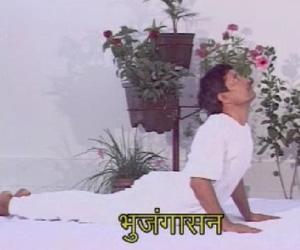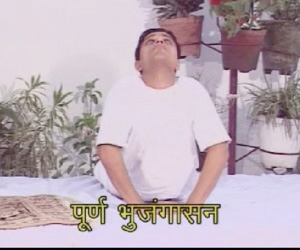Bhujangasana | Cobra Pose
Bhujang in Sanskrit means ‘cobra’ resembles the ‘hooded snake’ and it is a cobra pose. It is one of the important postures in yoga. Spine get stretched to strengthen the arms and back. Heart, chest and many physical and psychological benefits are attained in this posture.
Purna Bhujangasana
This is a variant of bhujangasana. Following is the picture. In this procedure, hands are put jointly at the front, just below the stomach.
Technique
1. Lie down on the stomach and relax all the muscles completely.
2. Rest the forehead on the floor.
3. Put the legs together and arms close to the body, keep hands beside the chest, palm facing ground.
4. Inhale slowly and raise the upper part of body including chest and head to the maximum extent possible just like cobra raising its hood.
5. Don’t create any jerk.
6. Bending of vertebrae is felt gradually, feel the pressure downwards from cervical, dorsal, lumbar and to the sacral portion of the body.
7. Position your chest and head upwards.
8. Try to maintain this position for thirty seconds.
9. Exhale slowly to bring down trunk smoothly to the floor, starting from navel area, thorax shoulders, chin and forehead.
10. The beginners can get the help of arms to raise upper part of body. The hands must remain together.
11. Try to put minimum weight on hands. Divide weight on spine and arms.
12. The thumb should touch the chest near armpit in final position
13. On coming back some persons bend their head first, avoid it . The part of the body which leaves the ground first will return to the ground last.
Duration
It should be practiced four-five times in one session.
Benefits
- Stimulates the endocrine system.
- The flexibility of spine is strengthened .
- Superficial muscles of the back toned up.
- The abdominal muscles strengthened.
- Useful in spinal disc problems including cervical spondylosis and slip disk.
Precautions
- This asana is strictly prohibited for pregnant women.
- Patients who are suffering from hernia, intestinal tuberculosis or hyperthyroidism should not perform this asana.
- The person suffering from peptic ulcers should avoid doing this posture
.

